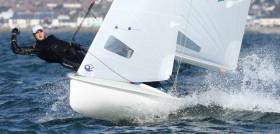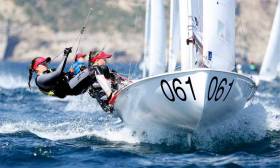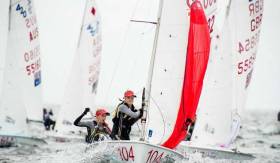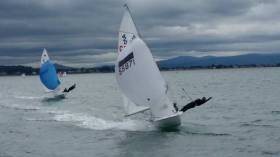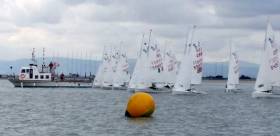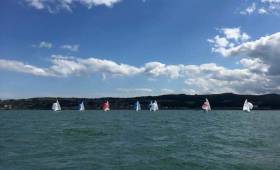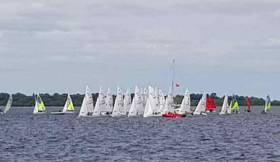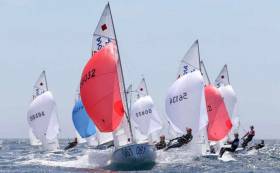Displaying items by tag: 420
420 Victory for Lyttle/Whyte Combination on Belfast Lough
For the first time in their domestic event season this year the 420s had some breeze to stretch their legs, it has taken until September for an event to provide moderate to strong breezes and the 2018 Ulster Championships duly delivered some great breeze as part of the RYA Northern Ireland Youth Championships hosted by the Royal North of Ireland Yacht Club.
Belfast Lough can provide some challenging conditions when the wind starts to build, Saturday provided a day with some early sunshine and a breeze in the 10-15 knots range with the occasional squall, but the Lyttle/Whyte combination scored three first places to lead overnight. Sunday promised more breeze which duly arrived and favoured the slightly heavier crews. Two races were run on Sunday before the race officer called it a day. The Lyttle/Whyte combination thrived in the stronger 17-20+ knot breeze and were pushed hard by the 2nd and 3rd place boats of Thompson/Quaid and Kane/Williamson. As the breeze strengthened to 20 knots and above the crews pushed the boats hard with some exhilarating sailing as the 420s planed both on the up and downwind legs of the course.
The final positions for the 2018 Ulster Championships were as follows:
1st Morgan Lyttle/Patrick Whyte – Royal St. George Yacht Club/Lough Ree Yacht Club
2nd Daniel Thompson/Dan Quaid – Wexford Harbour Boat and Tennis Club
3rd Lucy Kane/Abby Williamson – East Antrim Boat Club
Irish 420 Class Publishes 2019 Fixtures Calendar
With Autumn bringing on the start of a new academic year, the 420 Class Association traditionally takes a look ahead for the next twelve months to map out training and events through the remainder of 2018 and across 2019.
2017/18 was a busy 12 months with over 70 open training days around the country for sailors, including the October bank holiday training weekend and Schull training week. At home, the 420s had their four regional Championships, the 420 National Championships and the Volvo Irish Sailing Youth Pathway Nationals. In 2018 the 420 Association sent a team to the Junior European Championships in Portugal during the summer and were also represented at the 420 Worlds in Newport Rhode Island. The Irish 420 class were also represented at the UK National Championships, the UK Inland Championships and the UK Spring Championships plus regattas in La Rochelle, Palamos and San Remo making it one 2018 a very busy year to date for the class and there are still four months remaining in the year!
Looking ahead to the next 12 months the 420 Class Association has already planned a number of their own domestic events and tied these in with the International 420 calendar as currently known at this point in time:
2018
15th and 16th September - RYANI open training at Royal North of Ireland Yacht Club
29th and 30th September – 2018 420 Ulster Championships/RYANI Youth Nationals at Royal North of Ireland Yacht Club
20th and 21st October - UK Inland Championships at Rutland, a rerun of the event cancelled earlier in the year
27th to 29th October - October bank holiday weekend open training at the National Yacht Club, Dun Laoghaire
17th and 18th November – UK End of Season Championships at Grafham
2019
Monday 18th to Thursday 21st February - Schull Training week during Spring half term
22nd and 23rd February – 2019 Munster Championships, Schull
16th and 17th March – UK Inland Championships at Rutland
6th and 7th April – UK Spring Championships at Weymouth
Irish sailing Youth Pathway Nationals – Details to be confirmed
3rd to 11th July – 420 World Championships, Portugal
Junior European Championships- date and venue to be confirmed
Depending on dates for the Junior Europeans, dates for the following will be set:
2019 Irish National Championships
2019 Leinster Regional Championships
17th and 18th August – 2019 Connaught Championships at Galway Bay Sailing Club
September – 2019 Ulster Championships, date and venue TBC
National Yacht Club's Ferguson Sisters Compete at First 420 Worlds
Nicola and Fiona Ferguson from the National Yacht Club, Dun Laoghaire, competed in the 420 World Championships in Newport, Rhode Island, from 10th-15th August.
167 boats from 18 countries competed in this event. Sailors travelled from all parts of the USA, Australia, Canada, Chile, France, Great Britain, Germany, Greece, Israel, Italy, Japan, Mexico, New Zealand, Portugal, Spain, Switzerland and the US Virgin Islands. Nicola and Fiona were the only Irish team.
There were 3 fleets: 420 Open, Open Women’s and U17. Nicola and Fiona competed in the Open Women’s fleet. 12 races took place over the six-day event. Spanish sisters, Maria and Pilar Caba Hernandez won the Women's Open Championship, jumping from 5th place going into the final day.
The Spanish sailors dominated the podium, coming 1st, 2nd and 3rd in the Open Women's Championship. Nicola and Fiona Ferguson finished off the Championship in 31st position, which they are delighted with, being their first World’s event, which has no age limit for competing sailors.
420 Class Celebrate Special Week of Sailing at Howth Yacht Club
420 week concluded today at Howth Yacht Club with the third day of racing in the 2018 420 Open and National Championships. And what a week it was, it kicked off with a three-day training module followed by a second one-day training module prior to the start of championship racing.
The first two days of racing were in moderate winds. Day one produced a nine-point spread covering first to fifth positions and this spread increased to eighteen points at the end of day two when a pattern emerged with the GBR team of Alex Colquitt/Rebecca Coles putting together a string of race wins to carry a score of 6 points ahead of Grace O’Beirne/Kathy Kelly of the Royal St. George on 13 points and Gemma Mc Dowell/Emma Gallagher on 17 points of Malahide Yacht Club. Tied on 24 points each, fourth overall and third Irish boat were Micheal O’Suilleabhan/Rob Keal of Kinsale Yacht Club and Morgan Lyttle/Patrick White of the Royal St. George Yacht Club and Lough Ree Yacht Club respectively.
"It is never over until it is over and a lot can happen in the final downwind leg followed by a mark rounding to the finish"
So it was all to play for on the final day with two races held in a freshening but challenging breeze that was oscillating through 60 degrees and ranging from 6 to 14 knots. Alex Colquitt and Rebecca Coles had enough cushion to all but have wrapped up the open title so the real contest was going to be for the Irish National Champions title and the Irish Sailing medals. Race 8 allowed the leading GBR boat to nail down the Open Champions title with another win but the chase to be Irish Champion hotted up with Mc Dowell/Gallagher closing the gap on the leading Irish boat of O’Beirne/Kelly to three points. So all to play for in the last race and the title was won between the final weather mark and the finish. With Mc Dowell/Gallagher rounding the final weather mark in first place hotly pursued by Colquitt/Coles it looked as if they may have done enough to close out the 420 National Championship title with O’Beirne/Kelly rounding in fifth. But it is never over until it is over as the saying goes and a lot can happen in the final downwind leg followed by a mark rounding to the finish. The tight battle between the two leading boats in the final race ended with Colquitt/Coles claiming another win (see attached image) and the first two boats were able to then wait to see how the race was unfolding behind them. The next three boats were closely spaced and O’Beirne/Kelly were able to reel in the two boats ahead of them so that when a luffing duel started they were able to surge through to take third place in the final race and with it the title of Irish National Champions and first ladies crew.
The 420 Association congratulated Howth Yacht Club on their excellent hosting of the event, both the top quality training and the race management led by PRO Larry Power.
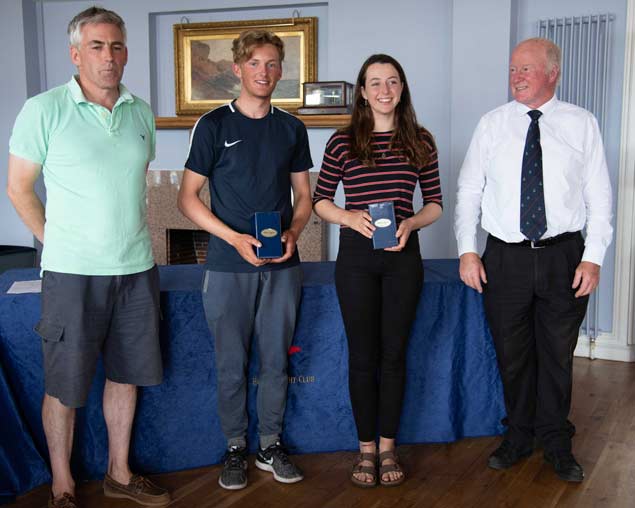 420 Nats 1st Gold and 2018 Open Champions Alex Colquitt and Rebecca Coles of West Kirby Sailing Club and Annadale Sailing Club
420 Nats 1st Gold and 2018 Open Champions Alex Colquitt and Rebecca Coles of West Kirby Sailing Club and Annadale Sailing Club
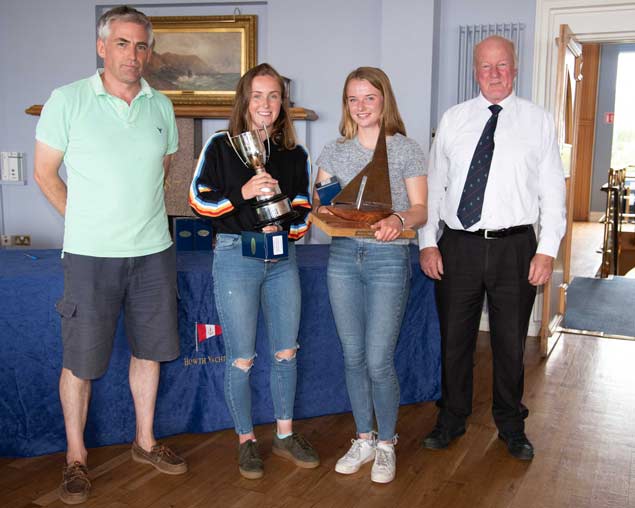 420 Nats 2nd Gold Irish National Champions and Irish Sailing Gold medalists Grace O'Beirne and Kathy Kelly Royal St George Yacht Club Yacht Club
420 Nats 2nd Gold Irish National Champions and Irish Sailing Gold medalists Grace O'Beirne and Kathy Kelly Royal St George Yacht Club Yacht Club
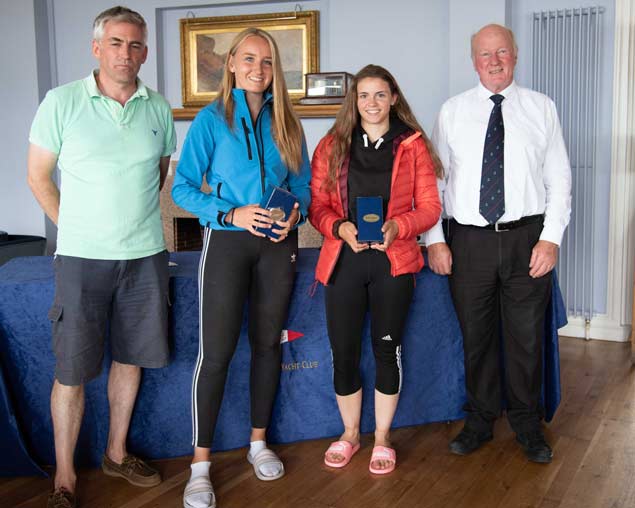 420 Nats 3rd Gold and Irish Sailing Silver medalists Gemma Mc Dowell and Emma Gallagher Malahide Yacht Club
420 Nats 3rd Gold and Irish Sailing Silver medalists Gemma Mc Dowell and Emma Gallagher Malahide Yacht Club
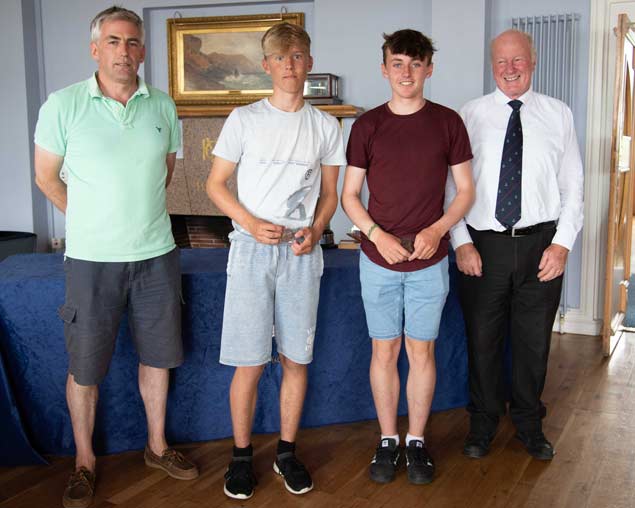 420 Nats 4th Gold and Irish Sailing Bronze medailists Micheal OSuilleabhain and Rob Keal Kinsale Yacht Club
420 Nats 4th Gold and Irish Sailing Bronze medailists Micheal OSuilleabhain and Rob Keal Kinsale Yacht Club
Gold fleet:
1st – 2018 420 Irish Open Champion – Alex Colquitt and Rebecca Coles of West Kirby Sailing Club and Annadale Sailing Club respectively
2nd – 2018 420 Irish Champion and first ladies crew plus Irish Sailing Gold medal winners – Grace O’Beirne and Kathy Kelly of the Royal St. George Yacht Club
3rd - Irish Sailing Silver medal winners – Gemma McDowell and Emma Gallagher of Malahide Yacht Club
4th - Irish Sailing Bronze medal winners – Micheal O’Suilleabhain and Rob Keal of Kinsale Yacht Club
 420 Nats 1st silver Daniel Hopkins and Robert OBrien Howth Yacht Club and Clontarf Yachting and Boating Club
420 Nats 1st silver Daniel Hopkins and Robert OBrien Howth Yacht Club and Clontarf Yachting and Boating Club
 420 Nats 2nd silver Cian Lynch and Daniel Thompson Wexford Harbour Boat and Tennis Club
420 Nats 2nd silver Cian Lynch and Daniel Thompson Wexford Harbour Boat and Tennis Club
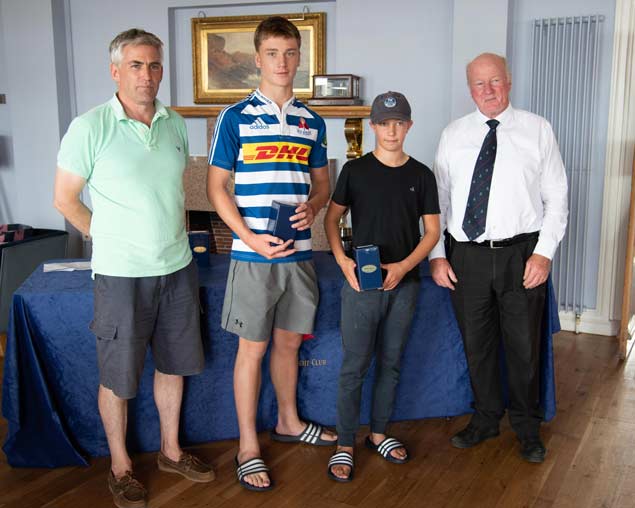 420 Nats 3rd silver Louis Mills and Harry Ingram Holyhead Sailing Club
420 Nats 3rd silver Louis Mills and Harry Ingram Holyhead Sailing Club
Silver fleet:
1st – Daniel Hopkins and Robert O’Brien of Howth Yacht Club and Clontarf Yacht and Boat Club respectively
2nd – Cian Lynch and Daniel Thompson of Wexford Harbour Boat and Tennis Club
3rd – Louis Milla and Harry Ingram of Holyhead Sailing Club
Colquitt & Coles on Target for Irish 420 Open Championship Title
As Day 2 of the 420 Nationals at Howth Yacht Club dawned to a dull grey sky and little wind the prospect of a first gun at 10:25 looked slim. But by 9:30 as the race committee boat headed out to the race area a gentle breeze had started to build.
By the start of racing a modest 8knt breeze had settled in and for a brief period in race 3 the wind crept above 13 knots allowing the race committee to permit pumping, rocking and ooching by flying flag “O”. At this wind speeds the 420s start to come into their element and began to plane upwind.
In total four races were sailed on Day 2, one ahead of the schedule for the event. The crews were back on land in good time despite the race officer having to reset the course between each race to account for oscillations in the wind.
The GBR combination of Colquitt/Coles had a perfect day with four bullets. With clean starts in all races the GBR team got to the windward mark first and with several Irish boats distracted by a battle for positions behind they were able to comfortably keep the pack behind them thereafter.
Bar some calamity Colquitt/Coles should be able to steer their way towards the Irish 420 Open Championship title with two races remaining and a score of 6 points. Battling it out behind them for the title of Irish Champion are Grace O’Beirne/Kathy Kelly of the Royal St. George on 13 points and Gemma Mc Dowell/Emma Gallagher Gallagher on 17 points of Malahide Yacht Club. Tied on 24 points each, fourth overall and third Irish boat, are Micheal O’Suilleabhan/Rob Keal of Kinsale Yacht Club and Morgan Lyttle/Patrick White of the Royal St. George Yacht Club and Lough Ree Yacht Club respectively.
GBR 420 Team Lead Irish Nationals at Howth Yacht Club
Today was day one of the 420 Nationals forming part of 420 week at Howth Yacht Club. With the two different training modules split over four days now behind the sailors, day one of racing was predicted to be light winds decreasing through the day. The fleet launched at eleven to head out to the race course assisted by a strong flooding tide.
Download results for the 19–boat fleet below.
Cloudy skies and a modest six-knot sea breeze greeted crews at the start of the first race but the skies soon cleared to bright sunshine and a slight increase in wind speed up to nine knots. The sometimes fickle wind and strong tide made for challenging racing but sitting on top of the leaderboard after three races are the GBR team of Colquitt/Coles who have a slender lead of one point over the Royal St. George pairing of Grace O’Beirne and Kathy Kelly.
Three more races are planned for day two of the Nationals with a modest increase in wind predicted. Day two will also see the fleet split into Gold and Silver.
420 girl crews claimed the top three places at the Connaught Regional Championships that took place this weekend as part of the Double Ree initiative at Lough Ree Yacht Club. Race Officer David Dickson did a magnificent job in running four double-handed classes for a series of seven races, each in testing conditions across the two days.
Racing on the Saturday was in light patchy winds that also produced large shifts. Gemma Mc Dowell and Emma Gallagher produced three bullets in the first three races followed by a fourth place to hold the overnight lead over local sailors Ben Graf and Alexander Farrell. Tied overnight for third place were Grace O’Beirne/Katherine Kelly and Nicola/Fiona Ferguson. Sunday brought more stable winds and two bullets for the Grace O’Beirne/Katherine Kelly crew, enough to lift them up to second place overall and just behind the Malahide Yacht Club pairing of Gemma Mc Dowell and Emma Gallagher. Nicola/Fiona Ferguson produced a bullet in the last race to secure third place overall. Results for both the Gold and Silver fleets are listed below, prize winners came from six separate clubs in a fleet representing nine clubs.
Next up for the 420s will be the National Championships hosted by Howth Yacht Club over the bank holiday weekend of the 4th, 5th and 6th August, an event that is attracting interest from crews across the water in the UK to participate.
Lough Ree Yacht Club and Commodore Garreth Leech are to be congratulated on the excellent initiative of running a double handed regatta to promote double-handed sailing for youth sailors. The organisation on and off the water was excellent, and with many families camping on land or using floating accommodation in the harbour, it all made for a very social evening on the Saturday at the clubhouse.
Gold Fleet:
1st Place – Gemma Mc Dowell and Emma Gallagher, Malahide Yacht Club
2nd Place – Grace O’Beirne and Katherine Kelly, Royal St. George Yacht Club
3rd Place – Nicola Ferguson and Fiona Ferguson, National Yacht Club
Silver Fleet:
1st Place – Liam Donnelly and Aidan Donnelly, Howth Yacht Club
2nd Place – Darragh Moreau and Robert O’Brien, Clontarf Yacht and Boat Club
3rd Place – Alex Leech and Lughaidh Crossdell, Lough Ree Yacht Club
With the 420 Junior European Team just back from Sesimbra in Portugal it is straight into the Connaught Regional Championships at Lough Ree Yacht Club to be followed shortly thereafter by the 420 Nationals at Howth Yacht Club.
The Junior Europeans event provided its usual red-hot level of competition across all the fleets. The Irish team had variable success with a number of top ten finishes sprinkled throughout the results. The International 420 Association working alongside Clube Naval de Sesimbra hosted a memorable event in what has to be one of the most picturesque event locations on the 420 International circuit. The event was based on the beach in the village centre of Sesimbra with launches at noon each day to catch the building breeze in the afternoon which provided winds ranging from light to moderate 15-20knts breezes.
The upcoming 420 Connaught Championships will be held as part of the Double Ree regatta on the 21st and 22nd July which is an inaugural double-handed Youth Regatta. This exciting new event will draw double- handed youth sailing classes together for an extravaganza of spinnaker flying racing with the 420s adding a high-performance dimension to the event.
420 Nationals at Howth
The 420 Nationals are being hosted by Howth Yacht this year, the event will take place over the bank holiday weekend from the 4th to the 6th August. The Nationals this year will also feature pre-event training over a number of days with Graeme Grant as the lead coach. The Howth venue has in the past attracted visitors from the UK over to compete and whilst the event does overlap with the 420 Worlds in Newport, Rhode Island it is likely some visitors will make it across.
The overlapping of the Irish 420 Nationals with the Worlds means that Ireland will be represented by Nicola and Fiona Ferguson who won the Irish Sailing Youth Pathway National Championships earlier in the year.
With the Schull training week and the Leinster Regional Championships already completed earlier in the year, the 420 Class Association are set for a busy summer of events starting with the 2018 Junior European Championships in Sesimbra, Portugal in early July.
Ireland will also be represented at the 420 Worlds in Newport Rhode Island later in the summer while back in Irish waters there will be the Connaught Championships on the 21st and 22nd July in Lough Ree Yacht Club followed by the National Championships at Howth Yacht Club on the 4th, 5th and 6th August, and the Ulsters on the 22nd and 23rd of September at the Royal North of Ireland Yacht Club to kick start the Autumn and Winter schedule.
The 420 is an Irish Sailing Pathway boat and for any sailors who would like to try sailing the boat, the Association have two boats for charter here.
The Association also run open days where sailors can use one of the association boats under the guidance of an experienced 420 sailor in order to get an understanding of how these high-performance boats handle.
If you would like the opportunity of trying out one of the boats please contact [email protected]
National Yacht Club's Ferguson Sisters Leapfrog to 420 Leinster Title at the Royal St. George
The 2018 420 Leinster Championships were hosted by the Royal St. George Yacht Club over the weekend in champagne sailing conditions. However Saturday morning looked ominous with a thick fog hanging over the harbour and the Stena Carrier moored at the Carlisle Pier barely visible from the boat deck of The George. The mist started to clear as PRO Barry O’Neil set out the plan for the weekend and soon after the fleet launched on the signal of the tea trolley being wheeled across the boat deck to deliver supplies to the committee boat.
 420 Leinster Championships dnghy racing on Dublin Bay
420 Leinster Championships dnghy racing on Dublin Bay
After a short delay to the start of race 1 whilst the fleet waited for the breeze to fill in, the race committee got three races off in quick succession to leave Micheal O'Suilleabhain and Michael Carroll of Kinsale Yacht Club leading the fleet at the end of day one. Sunday brought a day of unbroken sunshine and a perfect set of results for the Ferguson sisters who won all three races on the day to leapfrog to the top of the leader board.
The final results were as follows:
Gold Fleet
1st Nicola and Fiona Ferguson – National Yacht Club
2nd Micheal O'Suilleabhain and Michael Carroll – Kinsale Yacht Club
3rd Morgan Lyttle and Patrick Whyte – Royal St. George Yacht Club
Silver Fleet
1st Liam and Aidan Donnelly – Howth Yacht Club
2nd Emma Williams and Emily Arrowsmith – Royal St. George Yacht Club
3rd Jack Mc Dowell and Harry Thompson – Malahide Yacht Club/Wexford Harbour Boat and Tennis Club


























